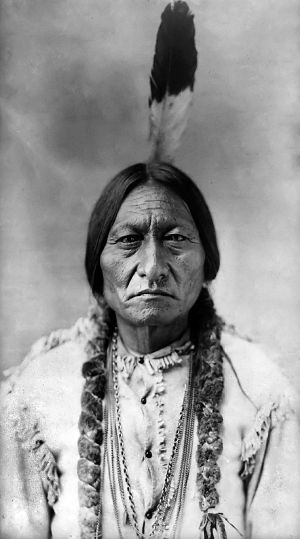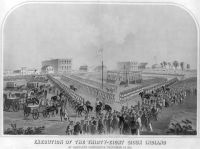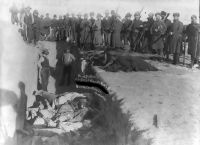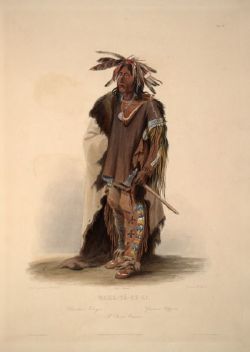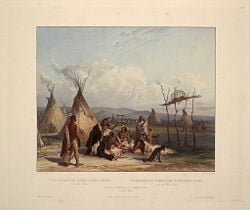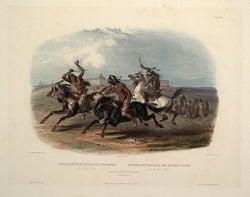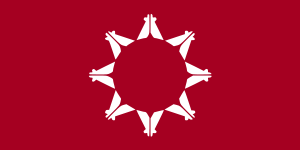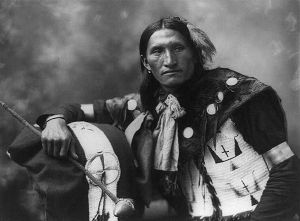Difference between revisions of "Sioux" - New World Encyclopedia
| Line 12: | Line 12: | ||
The Sioux comprise three major divisions based on dialect and subculture: | The Sioux comprise three major divisions based on dialect and subculture: | ||
| − | *Teton (“Dwellers on the Prairie”): the westernmost Sioux, known for their hunting and warrior culture, and are often referred to as the [[ | + | *Teton (“Dwellers on the Prairie”): the westernmost Sioux, known for their hunting and warrior culture, and are often referred to as the [[Lakota]]. |
| − | *Isanti ("Knife," originating from the name of a lake in present-day [[Minnesota]]): residing in the extreme east of the [[Dakotas]], Minnesota, and northern [[Iowa]], and are often referred to as the Santee or Dakota. | + | *Isanti ("Knife," originating from the name of a lake in present-day [[Minnesota]]): residing in the extreme east of the [[Dakotas]], Minnesota, and northern [[Iowa]], and are often referred to as the Santee or [[Dakota]]. |
| − | *Ihanktowan-Ihanktowana ("Village-at-the-end" and "little village-at-the-end"): residing in the Minnesota River area, they are considered to be the middle Sioux, and are often referred to as the Yankton-Yanktonai or Nakota. | + | *Ihanktowan-Ihanktowana ("Village-at-the-end" and "little village-at-the-end"): residing in the Minnesota River area, they are considered to be the middle Sioux, and are often referred to as the Yankton-Yanktonai or [[Nakota]]. |
| + | |||
| + | The term ''Dakota'' has also been applied by anthropologists and governmental departments to refer to all Sioux groups, resulting in names such as ''Teton Dakota'', ''Santee Dakota'', etc. This was due in large part to the misrepresented translation of the Ottawa word from which ''Sioux'' is derived (supposedly meaning "snake").<ref name="life and customs">{{cite book | last = Hassrick | first = Royal B. | coauthors = Dorothy Maxwell, Cile M. Bach | title = The Sioux: Life and Customs of a Warrior Society | publisher = University of Oklahoma Press | date = 1964 | pages = | month = | isbn = 0-8061-0607-7 }}</ref> | ||
==History== | ==History== | ||
| − | The earliest known European record of the Sioux was in Minnesota, Iowa, and Wisconsin.<ref name="riggs"/> Furthermore, after the introduction of the horse, the Sioux dominated larger areas of land—from present day [[Canada]] to the [[Platte River]], from Minnesota to the [[Yellowstone River]], including the [[Black Hills]] and the [[Powder River]] country.<ref name="dog soldiers"/> | + | The earliest known European record of the Sioux was in Minnesota, Iowa, and Wisconsin.<ref name="riggs">{{cite book | last = Riggs | first =Stephen R. | coauthors = | title = Dakota Grammar, Texts, and Ethnography | publisher = Washington Government Printing Office, Ross & Haines, Inc. | date =1893 | pages = | month = | isbn = 0-87018-052-5 }}</ref> Furthermore, after the introduction of the horse, the Sioux dominated larger areas of land—from present day [[Canada]] to the [[Platte River]], from Minnesota to the [[Yellowstone River]], including the [[Black Hills]] and the [[Powder River]] country.<ref name="dog soldiers">{{cite book | last = Mails | first =Thomas E. | coauthors = | title = Dog Soldiers, Bear Men, and Buffalo Women: A Study of the Societies and Cults of the Plains Indians | publisher = Prentice-Hall, Inc. | date =1973 | pages = | month = | isbn = 013-217216-X }}</ref> |
===Alliance with French fur merchants=== | ===Alliance with French fur merchants=== | ||
| Line 70: | Line 72: | ||
The earlier linguistic 3-way division of the Dakotan branch of the [[Siouan languages|Siouan family]] identified ''Lakota'', ''Dakota'', and ''Nakota'' as dialects of a single language, where Lakota = Teton, Dakota = Santee and Yankton, Nakota = Yanktonai & [[Assiniboine]]. This classification was based in large part on each group's particular pronunciation of the autonym ''Dakhóta-Lakhóta-Nakhóta'', meaning the Yankton-Yanktonai, Santee, and Teton groups all spoke mutually intelligible varieties of a [[Sioux language|Sioux idiom]].<ref name="riggs"/> However, more recent study identifies Assiniboine and Stoney as two separate languages with Sioux being the third language that has three similar dialects: Teton, Santee-Sisseton, Yankton-Yanktonai. Furthermore, the Yankton-Yanktonai never referred to themselves using the pronunciation ''Nak<sup>h</sup>óta'' but rather pronounced it the same as the Santee (i.e. ''Dak<sup>h</sup>óta''). (Assiniboine and Stoney speakers use the pronunciation ''Nak<sup>h</sup>óta'' or ''Nak<sup>h</sup>óda''). | The earlier linguistic 3-way division of the Dakotan branch of the [[Siouan languages|Siouan family]] identified ''Lakota'', ''Dakota'', and ''Nakota'' as dialects of a single language, where Lakota = Teton, Dakota = Santee and Yankton, Nakota = Yanktonai & [[Assiniboine]]. This classification was based in large part on each group's particular pronunciation of the autonym ''Dakhóta-Lakhóta-Nakhóta'', meaning the Yankton-Yanktonai, Santee, and Teton groups all spoke mutually intelligible varieties of a [[Sioux language|Sioux idiom]].<ref name="riggs"/> However, more recent study identifies Assiniboine and Stoney as two separate languages with Sioux being the third language that has three similar dialects: Teton, Santee-Sisseton, Yankton-Yanktonai. Furthermore, the Yankton-Yanktonai never referred to themselves using the pronunciation ''Nak<sup>h</sup>óta'' but rather pronounced it the same as the Santee (i.e. ''Dak<sup>h</sup>óta''). (Assiniboine and Stoney speakers use the pronunciation ''Nak<sup>h</sup>óta'' or ''Nak<sup>h</sup>óda''). | ||
| − | The | + | The name "Sioux" is an abbreviated form of ''Nadouessioux'' borrowed into [[French Canadian]] from ''Nadoüessioüak'' from the early [[Ottawa (tribe)|Ottawa]] [[exonym]]: ''na•towe•ssiwak'' "Sioux." It was first used by [[Jean Nicolet]] in 1640.<ref name="Sioux nation">{{cite book | last =Johnson | first =Michael | coauthors = | title= The Tribes of the Sioux Nation | publisher =Osprey Publishing Oxford | date =2000 | pages = | month = | isbn = 185532878X }}</ref> The [[Proto-Algonquian language|Proto-Algonquian]] form ''*nātowēwa'' meaning "Northern Iroquoian" has reflexes in several daughter languages that refer to a small rattlesnake ([[massasauga]], ''Sistrurus'').<ref name="riggs">{{cite book | last = Riggs | first =Stephen R. | coauthors = | title = Dakota Grammar, Texts, and Ethnography | publisher = Washington Government Printing Office, Ross & Haines, Inc. | date =1893 | pages = | month = | isbn = 0-87018-052-5 }}</ref> This information was interpreted by some that the Ottawa borrowing was an insult. However, this proto-Algonquian term most likely is ultimately derived from a form ''*-ātowē'' meaning simply "speak foreign language," which was later extended in meaning in some Algonquian languages to refer to the massasauga. Thus, contrary to many accounts, the Ottawa word ''na·towe·ssiwak'' never equated the Sioux with snakes. This is not confirmed though, as usage over the previous decades has led to this term having negative connotations to those tribes to which it refers. This would explain why many tribes have rejected this term when referring to themselves. |
| − | + | Some of the tribes have formally or informally adopted traditional names: the Rosebud Sioux Tribe is also known as the Sicangu Oyate, and the Oglala often use the name Oglala Lakota Oyate, rather than the English "Oglala Sioux Tribe" or OST. (The alternative English spelling of Ogallala is considered improper).<ref name="Sioux nation"/> | |
| − | |||
| − | Some of the tribes have formally or informally adopted traditional names: the Rosebud Sioux Tribe is also known as the Sicangu Oyate, and the Oglala often use the name Oglala Lakota Oyate, rather than the English "Oglala Sioux Tribe" or OST. (The alternative English spelling of Ogallala is considered improper).<ref name=" | ||
==== Derived names==== | ==== Derived names==== | ||
| Line 113: | Line 113: | ||
The Wicasa Itacans would elect two to four ''Shirt Wearers'' who were the voice of the Wicasa. Concerned with the welfare of the nation, they could settle quarrels among families or with foreign nations, among their responsibilities.<ref name="life and customs"/> Shirt Wearers were generally elected from highly respected sons of the leaders; however, men with obscure parents who displayed outstanding leaderships skills and had earned the respect of the community could be elected, exemplified by [[Crazy Horse]].<ref name="life and customs"/> | The Wicasa Itacans would elect two to four ''Shirt Wearers'' who were the voice of the Wicasa. Concerned with the welfare of the nation, they could settle quarrels among families or with foreign nations, among their responsibilities.<ref name="life and customs"/> Shirt Wearers were generally elected from highly respected sons of the leaders; however, men with obscure parents who displayed outstanding leaderships skills and had earned the respect of the community could be elected, exemplified by [[Crazy Horse]].<ref name="life and customs"/> | ||
| − | Under the Shirt Wearers were the ''Wakincuza'', or Pipe Holders. They held a prominent position during peace ceremonies, regulated camp locations, and supervised the Akicita societies during buffalo hunts. | + | Under the Shirt Wearers were the ''Wakincuza'', or Pipe Holders. They held a prominent position during peace ceremonies, regulated camp locations, and supervised the Akicita societies during buffalo hunts.<ref name="dog soldiers"/> |
| − | + | [[Image:A Sioux warrior 0041v.jpg|thumb|250px|right|Wahktageli ("Coward Warrior"), a Yankton Sioux chief ([[Karl Bodmer]])]] | |
| − | <ref name="dog soldiers"/> | + | [[Image:Funeral scaffold of a Sioux chief 0044v.jpg|thumb|250px|right|Funeral scaffold of a Sioux chief (Karl Bodmer]] |
| − | [[Image:A Sioux warrior 0041v.jpg|thumb|250px|right|Wahktageli ("Coward Warrior"), a Yankton Sioux chief ([[Karl Bodmer]])]][[Image:Funeral scaffold of a Sioux chief 0044v.jpg|thumb|250px|right|Funeral scaffold of a Sioux chief (Karl Bodmer]] | + | [[Image:Horse racing of the Sioux indians 0030v.jpg|thumb|250px|right|Horse racing of the Sioux (Karl Bodmer]] |
==Famous Sioux== | ==Famous Sioux== | ||
Revision as of 15:53, 21 October 2007
The Sioux (IPA /su/) are a Native American and First Nations people. The term can refer to any ethnic group within the Great Sioux Nation or any of the nation's many dialects. Today, the Sioux maintain many separate tribal governments scattered across several reservations and communities in the Dakotas, Minnesota, Nebraska, and also in Manitoba and southern Saskatchewan in Canada.
Introduction
The Sioux comprise three major divisions based on dialect and subculture:
- Teton (“Dwellers on the Prairie”): the westernmost Sioux, known for their hunting and warrior culture, and are often referred to as the Lakota.
- Isanti ("Knife," originating from the name of a lake in present-day Minnesota): residing in the extreme east of the Dakotas, Minnesota, and northern Iowa, and are often referred to as the Santee or Dakota.
- Ihanktowan-Ihanktowana ("Village-at-the-end" and "little village-at-the-end"): residing in the Minnesota River area, they are considered to be the middle Sioux, and are often referred to as the Yankton-Yanktonai or Nakota.
The term Dakota has also been applied by anthropologists and governmental departments to refer to all Sioux groups, resulting in names such as Teton Dakota, Santee Dakota, etc. This was due in large part to the misrepresented translation of the Ottawa word from which Sioux is derived (supposedly meaning "snake").[1]
History
The earliest known European record of the Sioux was in Minnesota, Iowa, and Wisconsin.[2] Furthermore, after the introduction of the horse, the Sioux dominated larger areas of land—from present day Canada to the Platte River, from Minnesota to the Yellowstone River, including the Black Hills and the Powder River country.[3]
Alliance with French fur merchants
Late in the 17th century, the Dakota entered into an alliance with French merchants,[4] who were trying to gain advantage in the struggle for the North American fur trade against the English, who had recently established the Hudson's Bay Company. The Dakota were thus lured into the European economic system and the bloody inter-aboriginal warfare that stemmed from it.
Dakota War of 1862
When 1862 arrived shortly after a failed crop the year before and a winter starvation, the federal payment was late. The local traders would not issue any more credit to the Santee and one trader, Andrew Myrick, went so far as to tell them that they were 'free to eat grass or their own dung'. As a result, on August 17, 1862 the Dakota War of 1862 began when a few Santee men murdered a white farmer and most of his family, igniting further attacks on white settlements along the Minnesota River. The Santee then attacked the trading post, and Myrick was later found among the dead with his mouth stuffed full of grass.[5]
On November 5, 1862 in Minnesota, in courts-martial, 303 Santee Sioux were found guilty of rape and murder of hundreds of Caucasian and European farmers and were sentenced to a hanging. No attorneys or witness were allowed as a defense for the accused, and many were convicted in less than five minutes of court time with the judge.[6] President Abraham Lincoln remanded the death sentence of 284 of the warriors, signing off on the execution of 38 Santee men by hanging on December 26, 1862 in Mankato, Minnesota, the largest mass-execution in US history.[7]
Afterwards, annuities to the Dakota were suspended for four years and the monies were awarded to the white victims. The men who were pardoned by President Lincoln were sent to a prison in Iowa, where more than half died while imprisoned.[6]
Aftermath of Dakota War
During and after the revolt, many Santee and their kin fled Minnesota and Eastern Dakota to Canada, or setted in the James River Valley in a short-lived reservation before being forced to move to Crow Creek Reservation on the east bank of the Missouri.[6] A few joined the Yanktonai and moved further west to join with the Lakota bands to continue their struggle against the United States military.[6]
Others were able to remain in Minnesota and the east, in small reservations existing into the 21st century, including Sisseton-Wahpeton, Flandreau, and Devils Lake (Spirit Lake or Fort Totten) Reservations in the Dakotas. Some ended up eventually in Nebraska, where the Santee Sioux Tribe today has a reservation on the south bank of the Missouri. Those who fled to Canada now have descendants residing on eight small Dakota Reserves, four of which are located in Manitoba (Sioux Valley, Long Plain [Dakota Tipi], Birdtail Creek, and Oak Lake [Pipestone]) and the remaining four (Standing Buffalo, Moose Woods [White Cap], Round Plain [Wahpeton], and Wood Mountain) in Saskatchewan.
Red Cloud's War
Red Cloud's War (also referred to as the Bozeman War) was an armed conflict between the Sioux and the United States in the Wyoming Territory and the Montana Territory from 1866 to 1868. The war was fought over control of the Powder River Country in north central Wyoming, which lay along the Bozeman Trail, a primary access route to the Montana gold fields.
The war is named after Red Cloud, a prominent chief of Oglala Sioux who led the war against the United States following encroachment into the area by the U.S. military. The war, which ended with the Treaty of Fort Laramie, resulted in a complete victory for the Sioux and the temporary preservation of their control of the Powder River country.[8]
Black Hills War
Between 1876 and 1877, the Black Hills War took place. The Lakota and their allies fought against the United States military in a series of conflicts. The earliest being the Battle of Powder River, and the final battle being at Wolf Mountain. Included are the Battle of the Rosebud, Battle of the Little Bighorn, Battle of Warbonnet Creek, Battle of Slim Buttes, Battle of Cedar Creek, and the Dull Knife Fight.
Wounded Knee Massacre
The Battle at Wounded Knee Creek was the last major armed conflict between the Lakota and the United States, subsequently described as a "massacre" by General Nelson A. Miles in a letter to the Commissioner of Indian Affairs.[9]
On December 29, 1890, five hundred troops of the U.S. 7th Cavalry, supported by four Hotchkiss guns (a lightweight artillery piece capable of rapid fire), surrounded an encampment of the Lakota bands of the Miniconjou and Hunkpapa [10] with orders to escort them to the railroad for transport to Omaha, Nebraska.
By the time it was over, 25 troopers and more than 150 Lakota Sioux lay dead, including men, women, and children. Some of the soldiers are believed to have been the victims of "friendly fire" as the shooting took place at point blank range in chaotic conditions.[11] Around 150 Lakota are believed to have fled the chaos, many of whom may have died from hypothermia.
Usage of the Ghost Dance reportedly insigated the massacre.
Forced relocation
Later in the 19th century, as the railroads hired hunters to exterminate the buffalo herds, their primary food supply, in order to force all tribes into sedentary habitations,[citation needed] the Santee and Lakota were forced to accept white-defined reservations in exchange for the rest of their lands, and domestic cattle and corn in exchange for buffalo, becoming dependent upon annual federal payments guaranteed by treaty. In Minnesota, the treaties of Traverse des Sioux and Mendota in 1851 left the Sioux with a reservation twenty miles (32 km) wide on each side of the Minnesota River.
Linguistics
The earlier linguistic 3-way division of the Dakotan branch of the Siouan family identified Lakota, Dakota, and Nakota as dialects of a single language, where Lakota = Teton, Dakota = Santee and Yankton, Nakota = Yanktonai & Assiniboine. This classification was based in large part on each group's particular pronunciation of the autonym Dakhóta-Lakhóta-Nakhóta, meaning the Yankton-Yanktonai, Santee, and Teton groups all spoke mutually intelligible varieties of a Sioux idiom.[2] However, more recent study identifies Assiniboine and Stoney as two separate languages with Sioux being the third language that has three similar dialects: Teton, Santee-Sisseton, Yankton-Yanktonai. Furthermore, the Yankton-Yanktonai never referred to themselves using the pronunciation Nakhóta but rather pronounced it the same as the Santee (i.e. Dakhóta). (Assiniboine and Stoney speakers use the pronunciation Nakhóta or Nakhóda).
The name "Sioux" is an abbreviated form of Nadouessioux borrowed into French Canadian from Nadoüessioüak from the early Ottawa exonym: na•towe•ssiwak "Sioux." It was first used by Jean Nicolet in 1640.[12] The Proto-Algonquian form *nātowēwa meaning "Northern Iroquoian" has reflexes in several daughter languages that refer to a small rattlesnake (massasauga, Sistrurus).[2] This information was interpreted by some that the Ottawa borrowing was an insult. However, this proto-Algonquian term most likely is ultimately derived from a form *-ātowē meaning simply "speak foreign language," which was later extended in meaning in some Algonquian languages to refer to the massasauga. Thus, contrary to many accounts, the Ottawa word na·towe·ssiwak never equated the Sioux with snakes. This is not confirmed though, as usage over the previous decades has led to this term having negative connotations to those tribes to which it refers. This would explain why many tribes have rejected this term when referring to themselves.
Some of the tribes have formally or informally adopted traditional names: the Rosebud Sioux Tribe is also known as the Sicangu Oyate, and the Oglala often use the name Oglala Lakota Oyate, rather than the English "Oglala Sioux Tribe" or OST. (The alternative English spelling of Ogallala is considered improper).[12]
Derived names
The U.S. states of North Dakota and South Dakota are named after the Dakota tribe. One other U.S. state has a name of Siouan origin: Minnesota is named from mni ("water") plus sota ("hazy/smoky, not clear"), and the name Nebraska comes from the related Chiwere language. Furthermore, the states Kansas, Iowa, and Missouri are named for cousin Siouan tribes, the Kansa, Iowa, and Missouri, respectively, as are the cities Omaha, Nebraska and Ponca City, Oklahoma. The names vividly demonstrate the wide dispersion of the Siouan peoples across the Midwest U.S.
More directly, several Midwestern municipalities utilize Sioux in their names, including Sioux City, Iowa, Sioux Center, Iowa, and Sioux Falls, South Dakota. Midwestern rivers include the Little Sioux River in Iowa and Big Sioux River along the Iowa/South Dakota border.
Many smaller towns and geographic features in the Northern Plains retain their Sioux names or English translations of those names, including Wasta, Owanka, Oacoma, Rapid City (Mne luza: "cataract" or "rapids"), Sioux Falls/Minnehaha County (Mne haha: "waterfall"), Belle Fourche (Mniwasta, or "Good water"), Inyan Kara, Sisseton (Sissetowan: tribal name), Winona ("first daughter"), etc.
Frontwoman Siouxsie Sioux of the postpunk band Siouxsie and the Banshees also derived her stage name from the "Sioux."
The University of North Dakota's athletic team is known as the "Fighting Sioux." While there is a local desire to retain the historic name, numerous Sioux tribes have issued resolutions asking the University to abolish it.[13][14]
The name Lakota comes from the Lakota autonym, lakhóta "feeling affection, friendly, united, allied." The early French literature does not distinguish a separate Teton division, instead lumping them into a "Sioux of the West" group with other Santee and Yankton bands.
The names Teton and Tintowan comes from the Lakota name thíthųwą (the meaning of which is obscure). This term was used to refer to the Lakota by non-Lakota Sioux groups. Other derivations include: Ti tanka, Tintonyanyan, Titon, Tintonha, Thintohas, Tinthenha, Tinton, Thuntotas, Tintones, Tintoner, Tintinhos, Ten-ton-ha, Thinthonha, Tinthonha, Tentouha, Tintonwans, Tindaw, Tinthow, Atintons, Anthontans, Atentons, Atintans, Atrutons, Titoba, Tetongues, Teton Sioux, Teeton, Ti toan, Teetwawn, Teetwans, Ti-t’-wawn, Ti-twans, Tit’wan, Tetans, Tieton, Teetonwan, etc.
As noted above, the early French sources call the Lakota Sioux with an additional modifier, such as Scioux of the West, West Schious, Sioux des prairies, Sioux occidentaux, Sioux of the Meadows, Nadooessis of the Plains, Prairie Indians, Sioux of the Plain, Maskoutens-Nadouessians, Mascouteins Nadouessi, and Sioux nomades.
Today many of the tribes continue to officially call themselves Sioux which the Federal Government of the United States applied to all Dakota/Lakota/Nakota people in the 19th and 20th centuries. However, some of the tribes have formally or informally adopted traditional names: the Rosebud Sioux Tribe is also known as the Sičangu Oyate (Brulé Nation), and the Oglala often use the name Oglala Lakota Oyate, rather than the English "Oglala Sioux Tribe" or OST. (The alternate English spelling of Ogallala is deprecated, even though it is closer to the correct pronunciation.) The Lakota have names for their own subdivisions.
Notable persons include Sitting Bull (Tatanka Iyotake) from the Hunkpapa band and Crazy Horse (Tašunka Witko), Red Cloud (Maĥpiya Luta), Black Elk (Hehaka Sapa) and Billy Mills from the Oglala band.
Culture
Political organization
The historical political organization was based on the participation of individuals and the cooperation of many to sustain the tribe’s way of life. Leadership was chosen from noble birth and through demonstrations of bravery, fortitude, generosity, and wisdom.[1]
Societies
The leadership positions were usually hereditary with future leaders being chosen by their war record and generosity. Tribal leaders were members of the Naca Ominicia society and decided matters of tribal hunts, camp movements, whether to make war or peace with their neighbors, or any other community action.[3] Societies were similar to fraternities, whereas the men joined to raise their position in the tribe. Societies were composed of smaller clans and varied in number among the seven divisions.[1] There were two types of societies: Akicita, for the younger men, and Naca, for elders and former leaders.[1]
Akicita societies
Akicita societies put their efforts into training men as warriors, participating in tribal hunts, policing, and upholding civility among the community.[3] There were many smaller Akicita societies, including the Kit-Fox, Strong Heart, Elk, and so on.[3]
Naca societies
Leaders in the Naca societies, per Naca Ominicia, were the tribal elders and leaders, who would elect seven to ten men, depending on the division, called Wicasa Itacans. The Wicasa Itacans interpreted and enforced the decisions of the Naca.[3]
The Wicasa Itacans would elect two to four Shirt Wearers who were the voice of the Wicasa. Concerned with the welfare of the nation, they could settle quarrels among families or with foreign nations, among their responsibilities.[1] Shirt Wearers were generally elected from highly respected sons of the leaders; however, men with obscure parents who displayed outstanding leaderships skills and had earned the respect of the community could be elected, exemplified by Crazy Horse.[1]
Under the Shirt Wearers were the Wakincuza, or Pipe Holders. They held a prominent position during peace ceremonies, regulated camp locations, and supervised the Akicita societies during buffalo hunts.[3]
Famous Sioux
Historical
- Taoyateduta (Little Crow)—Chief famous for role in the Dakota War of 1862
- Tatanka Iyotanke (Sitting Bull)—Chief famous for role in the Battle of Little Bighorn
- Makhpiya-luta (Red Cloud)—Chief famous for role in Red Cloud's War
- Tasunka Witko (Crazy Horse)—Famous for leadership and courage in battle
- Hehaka Sapa (Black Elk)—Lakota holy man, source of Black Elk Speaks and other books
- Tahca Ushte (Lame Deer)—Lakota holy man, carried traditional knowledge into modern era
- Charles Eastman—Author, physician and reformer
- Colonel Gregory "Pappy" Boyington—World War II Fighter Ace and Medal of Honor recipient; 1/4 Sioux
Modern
- Robert "Tree" Cody, Native American flutist (Dakota)
- Elizabeth Cook-Lynn, activist, academic, and writer
- Mary Crow Dog, writer and activist
- Vine Deloria, Jr., activist and essayist
- Indigenous, blues band (Nakota)
- Illinois Jacquet, jazz saxophonist (half Sioux and half African American)
- Russell Means, activist (Oglala)
- Ed McGaa, author, (Oglala) CPT US Marine Corp F-4 Phantom Fighter Pilot
- Eddie Spears, actor (Lakota Sioux Lower Brule)
- Michael Spears, actor (Lakota Sioux Lower Brule)
- John Trudell, actor
- Floyd Red Crow Westerman, singer and actor (Dakota)
- Leonard Peltier, imprisoned for allegedly killing two FBI agents in 1975
Contemporary Sioux
Today, one half of all enrolled Sioux in the United States live off the reservation. Also, to be an enrolled member in any of the Sioux tribes in the United States, 1/4 degree is require.[15]
In Canada, the Canadian goverment recognizes reserves as "First Nations." Lakota reservations recognized by the US government include:
- Oglala (Pine Ridge Indian Reservation)
- Brulé (Rosebud Indian Reservation)
- Hunkpapa (Standing Rock Reservation)
- Miniconjou (Cheyenne River Sioux Reservation)
- Sans Arcs (Cheyenne River Sioux Reservation)
- Siha Sapa (Cheyenne River Sioux Reservation)
- Two Kettles (Cheyenne River Sioux Reservation)
Some Lakota also live on other Sioux reservations in eastern South Dakota, Minnesota, and Nebraska:
- Santee, in Nebraska
- Crow Creek in Central South Dakota
- Yankton in Central South Dakota
- Flandreau in Eastern South Dakota
- Sisseton-Wahpehton in Northeastern South Dakota and Southeastern North Dakota
- Lower Sioux in Minnesota
- Upper Sioux in Minnesota
- Shakopee in Minnesota
- Prairie Island in Minnesota
In addition several Lakota live on Wood Mountain Indian Reserve often Wood Mountain First Nation northwest of Wood Mountain Post now a Saskatchewan historic site.
Modern geographic divisions
The Sioux maintain many separate tribal governments scattered across several reservations and communities in the Dakotas, Minnesota, Nebraska, and also in Manitoba and southern Saskatchewan in Canada.
Lakota
The Lakota (IPA: [laˈkˣota]) (also Lakhota, Teton, Titonwon) are a Native American tribe. They form one of a group of seven tribes (the Great Sioux Nation) and speak Lakota, one of the three major dialects of the Sioux language.
The Lakota are the westernmost of the three Sioux groups, occupying lands in both North and South Dakota. The seven branches or "sub-tribes" of the Lakota are Brulé, Oglala, Sans Arcs, Hunkpapa, Miniconjou, Sihasapa and Two Kettles.
Yankton-Yanktonai (Nakota)
The Ihanktowan-Ihanktowana, or the Yankton ("campers at the end") and Yanktonai ("lesser campers at the end") divisions consist of two bands or two of the seven council fires. According to Nasunatanka and Matononpa in 1880, the Yanktonai are divided into two sub-groups known as the Upper Yanktonai and the lower Yanktonai (Hunkpatina).[2]
Economically, they were involved in quarrying pipestone. The Yankton-Yanktonai moved into northern Minnesota. In the 1700s, they were recorded as living in the Mankato region of Minnesota.[16]
Santee (Dakota)
The Santee people migrated north and westward from the south and east into Ohio then to Minnesota. The Santee were a woodland people who thrived on hunting, fishing and subsistence farming. Migrations of Anishinaabe/Chippewa people from the east in the 17th and 18th centuries, with muskets supplied by the French and British, pushed the Santee further into Minnesota and west and southward, giving the name "Dakota Territory" to the northern expanse west of the Mississippi and up to its headwaters.[2]
Teton (Lakota)
The western Santee obtained horses, probably in the 17th century (although some historians date the arrival of horses in South Dakota to 1720), and moved further west, onto the Great Plains, becoming the Titonwan tribe, subsisting on the buffalo herds and corn-trade with their linguistic cousins, the Mandan and Hidatsa along the Missouri.[2]
Ethnic divisions
The Sioux are divided into ethnic groups, the larger of which are divided into sub-groups, and further branched into bands. The Yankton-Yanktonai, the smallest division, reside on the Yankton reservation in South Dakota and the Northern portion of Standing Rock Reservation, while the Santee live mostly in Minnesota and Nebraska, but include bands in the Sisseton-Wahpeton, Flandreau, and Crow Creek Reservations in South Dakota. The Lakota are the westernmost of the three groups, occupying lands in both North and South Dakota.
- Santee division (Dakota)
- Mdewakantonwan ("Dwellers of Spirit Lake")
- notable persons: Taoyateduta
- Sisitonwan (Sisseton, "Dwellers of the Fish Grounds")
- Wahpekute ("Leaf Shooters")
- notable persons: Inkpaduta
- Wahpetonwan ("Dwellers among the Leaves")
- Mdewakantonwan ("Dwellers of Spirit Lake")
- Yankton-Yanktonai division (Nakota)
- Ihanktonwan (Yankton, "End Village")
- Ihanktonwana (Yanktonai, "Little End Village")
- notable persons: Wanata
- Stoney (Canada)
- Assiniboine (Canada)
- Titonwan/Teton division (Lakota) ("Dwellers on the Prairie")
- Oglala ("Those who Scatter their own")
- notable persons: Crazy Horse, Red Cloud, Black Elk and Billy Mills (Olympian)
- Hunkpapa (meaning "Those who Camp by the Door" or "Wanderers")
- notable persons: Sitting Bull
- Sihasapa (not to confuse with the Algonquian-speaking Blackfeet)
- Minniconjou ("Those who Plant by the Stream")
- notable persons: Lone Horn, Touch the Clouds
- Sićangu (French: Brulé) ("Burnt Thighs")
- Itazipacola (French: Sans Arcs "Without Bows")
- Oohenonpa ("Two Kettles" or "Two Boilings")
- Oglala ("Those who Scatter their own")
Notes
- ↑ 1.0 1.1 1.2 1.3 1.4 1.5 Hassrick, Royal B. and Dorothy Maxwell, Cile M. Bach (1964). The Sioux: Life and Customs of a Warrior Society. University of Oklahoma Press. ISBN 0-8061-0607-7.
- ↑ 2.0 2.1 2.2 2.3 2.4 2.5 Riggs, Stephen R. (1893). Dakota Grammar, Texts, and Ethnography. Washington Government Printing Office, Ross & Haines, Inc.. ISBN 0-87018-052-5.
- ↑ 3.0 3.1 3.2 3.3 3.4 3.5 Mails, Thomas E. (1973). Dog Soldiers, Bear Men, and Buffalo Women: A Study of the Societies and Cults of the Plains Indians. Prentice-Hall, Inc.. ISBN 013-217216-X.
- ↑ van Houten, Gerry (1991). Corporate Canada An Historical Outline. Progress Books, 6-7.
- ↑ Mark, Steil; Tim Post, "m/part2.shtml Let them eat grass", Minnesota Public Radio, 2002-09-26. Retrieved 2007-05-08.
- ↑ 6.0 6.1 6.2 6.3 Time-Life Books (1994). War for the Plains. Time-Life Books. ISBN 0-8094-9445-0.
- ↑ Mark, Steil; Tim Post, "m/part5.shtml Execution and expulsion", Minnesota Public Radio, 2002-09-26. Retrieved 2007-05-08.
- ↑ *Brown, Dee (1970). Bury My Heart at Wounded Knee, ch. 6. Bantam Books. ISBN 0-5531-1979-6.
- ↑ Letter: General Nelson A. Miles to the Commissioner of Indian Affairs, March 13, 1917.
- ↑ Liggett, Lorie (1998). Wounded Knee Massacre - An Introduction. Bowling Green State University. Retrieved 2007-03-02.
- ↑ Strom, Karen (1995). The Massacre at Wounded Knee. Karen Strom.
- ↑ 12.0 12.1 Johnson, Michael (2000). The Tribes of the Sioux Nation. Osprey Publishing Oxford. ISBN 185532878X.
- ↑ Associated Press, "North Dakota to appeal ruling on Sioux mascot", 2005-09-25. Retrieved 2007-08-18.
- ↑ Tribal Resolutions and other Resolutions asking for the removal of the "Fighting Sioux" moniker and name. Retrieved 2007-08-18.
- ↑ Enrollment Ordinance. Retrieved 2007-08-11.
- ↑ OneRoad, Amos E. and Alanson Skinner (2003). Begin Dakota: Tales and Traditions of the Sisseton and Wahpeton. Minnesota Historical Society. ISBN 0-87351-453-X.
Bibliography
- Christafferson, Dennis M. (2001). Sioux, 1930-2000. In R. J. DeMallie (Ed.), Handbook of North American Indians: Plains (Vol. 13, Part 2, pp. 821-839). W. C. Sturtevant (Gen. Ed.). Washington, D.C.: Smithsonian Institution. ISBN 0-16-050400-7.
- DeMallie, Raymond J. (2001a). Sioux until 1850. In R. J. DeMallie (Ed.), Handbook of North American Indians: Plains (Vol. 13, Part 2, pp. 718-760). W. C. Sturtevant (Gen. Ed.). Washington, D.C.: Smithsonian Institution. ISBN 0-16-050400-7.
- DeMallie, Raymond J. (2001b). Teton. In R. J. DeMallie (Ed.), Handbook of North American Indians: Plains (Vol. 13, Part 2, pp. 794-820). W. C. Sturtevant (Gen. Ed.). Washington, D.C.: Smithsonian Institution. ISBN 0-16-050400-7.
- Hein, David (Advent 2002). "Episcopalianism among the Lakota / Dakota Indians of South Dakota." The Historiographer, vol. 40, pp. 14-16. [The Historiographer is a publication of the Historical Society of the Episcopal Church and the National Episcopal Historians and Archivists.]
- Hein, David (1997). "Christianity and Traditional Lakota / Dakota Spirituality: A Jamesian Interpretation." The McNeese Review, vol. 35, pp. 128-38.
- Matson, William and Frethem, Mark (2006). Producers. "The Authorized Biography of Crazy Horse and His Family Part One: Creation, Spirituality, and the Family Tree." The Crazy Horse family tells their oral history and with explanations of Lakota spirituality and culture on DVD. (Publisher is Reelcontact.com)
- Parks, Douglas R.; & Rankin, Robert L. (2001). The Siouan languages. In R. J. DeMallie (Ed.), Handbook of North American Indians: Plains (Vol. 13, Part 1, pp. 94-114). W. C. Sturtevant (Gen. Ed.). Washington, D.C.: Smithsonian Institution. ISBN 0-16-050400-7.
- Albers, Patricia C. (2001). Santee. In R. J. DeMallie (Ed.), Handbook of North American Indians: Plains (Vol. 13, Part 2, pp. 761-776). W. C. Sturtevant (Gen. Ed.). Washington, D.C.: Smithsonian Institution. ISBN 0-16-050400-7.
- Brown, Dee, Bury My Heart at Wounded Knee, Holt, Rinehart & Winston, 1970.
- Christafferson, Dennis M. (2001). Sioux, 1930-2000. In Handbook of North American Indians: Plains (Vol. 13, Part 2, pp. 821-839). Washington, D.C.: Smithsonian Institution.
- Cox, Hank H. (2005). Lincoln and the Sioux Uprising of 1862. Nashville, TN: Cumberland House. ISBN 1-58182-457-2.
- DeMallie, Raymond J. (2001a). Sioux until 1850. In Handbook of North American Indians: Plains (Vol. 13, Part 2, pp. 718-760). Washington, D.C.: Smithsonian Institution.
- DeMallie, Raymond J. (2001b). Teton. In Handbook of North American Indians: Plains (Vol. 13, Part 2, pp. 794-820). Washington, D.C.: Smithsonian Institution.
- DeMallie, Raymond J. (2001c). Yankton and Yanktonai. In Handbook of North American Indians: Plains (Vol. 13, Part 2, pp. 777-793). Washington, D.C.: Smithsonian Institution.
- DeMallie, Raymond J.; & Miller, David R. (2001). Assiniboine. In Handbook of North American Indians: Plains (Vol. 13, Part 1, pp. 572-595). Washington, D.C.: Smithsonian Institution.
- Getty, Ian A. L.; & Gooding, Erik D. (2001). Stoney. In Handbook of North American Indians: Plains (Vol. 13, Part 1, pp. 596-603). Washington, D.C.: Smithsonian Institution.
- Hein, David (Advent 2002). "Episcopalianism among the Lakota / Dakota Indians of South Dakota." The Historiographer, vol. 40, pp. 14-16. [The Historiographer is a publication of the Historical Society of the Episcopal Church and the National Episcopal Historians and Archivists.]
- Hein, David (1997). "Christianity and Traditional Lakota / Dakota Spirituality: A Jamesian Interpretation." The McNeese Review, vol. 35, pp. 128-38.
- Parks, Douglas R.; & Rankin, Robert L. (2001). The Siouan languages. In Handbook of North American Indians: Plains (Vol. 13, Part 1, pp. 94-114). Washington, D.C.: Smithsonian Institution.
- Sullivan, Maurice S.: "Jedediah Smith, Trader and Trail Breaker," New York Press of the Pioneers (1936) contains 'politically incorrect' white man's terminology and stereotypical attitudes toward the 'Indians'.
- Robert M. Utley, "The Last Days of the Sioux Nation" (Yale University, 1963) ISBN 0-300-00245-9
External links
- Lakhota Sioux Heritage Language & Culture Site
- Dakota Blues: The History of The Great Sioux Nation
- The Yanktonai (Edward S. Curtis)
- Lakota Language Consortium
- Winter Counts a Smithsonian exhibit of the annual icon chosen to represent the major event of the past year
- Rosebud Indian Reservation Land of the Sicangu Lakota Oyate
- Dakota Language and Culture Encyclopedia
- Dakota Blues: The History of The Great Sioux Nation
- Lakhota.Com The Leading Lakota Sioux Resource teaching Language and History since 1995 - run by members of the Cheyenne River Sioux Tribe
- The Teton Sioux (Edward S. Curtis)
- Lakota Language Consortium (Indiana)
- Lakota Winter Counts a Smithsonian exhibit of the annual icon chosen to represent the major event of the past year
- Lakota Herbs (Canada)
Credits
New World Encyclopedia writers and editors rewrote and completed the Wikipedia article in accordance with New World Encyclopedia standards. This article abides by terms of the Creative Commons CC-by-sa 3.0 License (CC-by-sa), which may be used and disseminated with proper attribution. Credit is due under the terms of this license that can reference both the New World Encyclopedia contributors and the selfless volunteer contributors of the Wikimedia Foundation. To cite this article click here for a list of acceptable citing formats.The history of earlier contributions by wikipedians is accessible to researchers here:
The history of this article since it was imported to New World Encyclopedia:
Note: Some restrictions may apply to use of individual images which are separately licensed.
